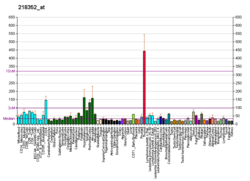Protein-coding gene in the species Homo sapiens
| RCBTB1 |
|---|
|
| Identifiers |
|---|
| Aliases | RCBTB1, CLLD7, CLLL7, GLP, RCC1 and BTB domain containing protein 1, RDEOA |
|---|
| External IDs | OMIM: 607867; MGI: 1918580; HomoloGene: 10061; GeneCards: RCBTB1; OMA:RCBTB1 - orthologs |
|---|
| Gene location (Mouse) |
|---|
 | | Chr. | Chromosome 14 (mouse)[1] |
|---|
| | Band | 14|14 C3 | Start | 59,438,658 bp[1] |
|---|
| End | 59,474,714 bp[1] |
|---|
|
| RNA expression pattern |
|---|
| Bgee | | Human | Mouse (ortholog) |
|---|
| | Top expressed in | - gastrula
- deep cerebellar nuclei
- tail of embryo
- ventricular zone
- submandibular gland
- ganglionic eminence
- genital tubercle
- globus pallidus
- ventral tegmental area
- pineal gland
|
| |
|
|---|
| BioGPS |  | | More reference expression data |
|
|---|
|
| Orthologs |
|---|
| Species | Human | Mouse |
|---|
| Entrez | | |
|---|
| Ensembl | | |
|---|
| UniProt | | |
|---|
| RefSeq (mRNA) | | |
|---|
NM_027764
NM_001360610
NM_001360611 |
|
|---|
| RefSeq (protein) | NP_060661
NP_001339429
NP_001339430
NP_001339431
NP_001339432
|
|---|
NP_001339433
NP_001339434
NP_001339435 |
| |
|---|
NP_082040
NP_001347539
NP_001347540 |
|
|---|
| Location (UCSC) | n/a | Chr 14: 59.44 – 59.47 Mb |
|---|
| PubMed search | [2] | [3] |
|---|
|
| Wikidata |
| View/Edit Human | View/Edit Mouse |
|
RCC1 and BTB domain-containing protein 1 is a protein that in humans is encoded by the RCBTB1 gene.[4][5]
This gene encodes a protein with an N-terminal RCC1 domain and a C-terminal BTB (broad complex, tramtrack and bric-a-brac) domain. In rats, over-expression of this gene in vascular smooth muscle cells induced cellular hypertrophy. The C-terminus of RCBTB1 interacts with the angiotensin II receptor-1A. In humans, this gene maps to a region of chromosome 13q that is frequently deleted in B-cell chronic lymphocytic leukemia and other lymphoid malignancies.[5]
References
- ^ a b c GRCm38: Ensembl release 89: ENSMUSG00000035469 – Ensembl, May 2017
- ^ "Human PubMed Reference:". National Center for Biotechnology Information, U.S. National Library of Medicine.
- ^ "Mouse PubMed Reference:". National Center for Biotechnology Information, U.S. National Library of Medicine.
- ^ Mabuchi H, Fujii H, Calin G, Alder H, Negrini M, Rassenti L, Kipps TJ, Bullrich F, Croce CM (Apr 2001). "Cloning and characterization of CLLD6, CLLD7, and CLLD8, novel candidate genes for leukemogenesis at chromosome 13q14, a region commonly deleted in B-cell chronic lymphocytic leukemia". Cancer Res. 61 (7): 2870–7. PMID 11306461.
- ^ a b "Entrez Gene: RCBTB1 regulator of chromosome condensation (RCC1) and BTB (POZ) domain containing protein 1".
Further reading
- Hartley JL, Temple GF, Brasch MA (2001). "DNA Cloning Using In Vitro Site-Specific Recombination". Genome Res. 10 (11): 1788–95. doi:10.1101/gr.143000. PMC 310948. PMID 11076863.
- Wiemann S, Weil B, Wellenreuther R, et al. (2001). "Toward a Catalog of Human Genes and Proteins: Sequencing and Analysis of 500 Novel Complete Protein Coding Human cDNAs". Genome Res. 11 (3): 422–35. doi:10.1101/gr.GR1547R. PMC 311072. PMID 11230166.
- Simpson JC, Wellenreuther R, Poustka A, et al. (2001). "Systematic subcellular localization of novel proteins identified by large-scale cDNA sequencing". EMBO Rep. 1 (3): 287–92. doi:10.1093/embo-reports/kvd058. PMC 1083732. PMID 11256614.
- Strausberg RL, Feingold EA, Grouse LH, et al. (2003). "Generation and initial analysis of more than 15,000 full-length human and mouse cDNA sequences". Proc. Natl. Acad. Sci. U.S.A. 99 (26): 16899–903. Bibcode:2002PNAS...9916899M. doi:10.1073/pnas.242603899. PMC 139241. PMID 12477932.
- Solomou EE, Sfikakis PP, Kotsi P, et al. (2004). "13q deletion in chronic lymphocytic leukemia: characterization of E4.5, a novel chromosome condensation regulator-like guanine nucleotide exchange factor". Leuk. Lymphoma. 44 (9): 1579–85. doi:10.3109/10428190309178782. PMID 14565662. S2CID 41439989.
- Ota T, Suzuki Y, Nishikawa T, et al. (2004). "Complete sequencing and characterization of 21,243 full-length human cDNAs". Nat. Genet. 36 (1): 40–5. doi:10.1038/ng1285. PMID 14702039.
- Guo DF, Tardif V, Ghelima K, et al. (2004). "A novel angiotensin II type 1 receptor-associated protein induces cellular hypertrophy in rat vascular smooth muscle and renal proximal tubular cells". J. Biol. Chem. 279 (20): 21109–20. doi:10.1074/jbc.M401544200. PMID 14985364.
- Dunham A, Matthews LH, Burton J, et al. (2004). "The DNA sequence and analysis of human chromosome 13". Nature. 428 (6982): 522–8. Bibcode:2004Natur.428..522D. doi:10.1038/nature02379. PMC 2665288. PMID 15057823.
- Wiemann S, Arlt D, Huber W, et al. (2004). "From ORFeome to Biology: A Functional Genomics Pipeline". Genome Res. 14 (10B): 2136–44. doi:10.1101/gr.2576704. PMC 528930. PMID 15489336.
- Mehrle A, Rosenfelder H, Schupp I, et al. (2006). "The LIFEdb database in 2006". Nucleic Acids Res. 34 (Database issue): D415–8. doi:10.1093/nar/gkj139. PMC 1347501. PMID 16381901.
















